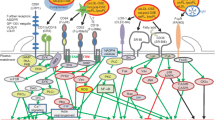Increased concentration of lipoprotein(a) is a risk factor of coronary heart disease. lipoprotein(a) consists of LDL-like and highly polymorphic apolipoprotein(a). Here we studied the effect of lipoprotein(a)-containing sera with different apolipoprotein(a) phenotypes on lipid accumulation by THP-1 monocyte-like cells. Cholesterol concentration in lysates of THP-1 cells was significantly higher after their incubation with lipoprotein(a)-containing serum samples with low-molecular-weight phenotype of apolipoprotein(a) in comparison with samples with a high-molecular-weight apolipoprotein(a) phenotype irrespective of initial cholesterol level as well as serum concentrations of apoB-100, oxidized LDL, and circulating immune complexes. The presence of the most atherogenic small dense LDL subfractions in examined sera in addition to a low-molecular-weight apolipoprotein(a) phenotype resulted in significant elevation of cholesterol accumulation by THP-1 cells. The data obtained explain greater atherogenicity of lipoprotein(a) with low-molecular-weight apolipoprotein(a) phenotype.
Similar content being viewed by others
References
Afanas’eva OI, Adamova IYu, Benevolenskaya GF, Pokrovskii SN. Enzyme immunoassay of lipoprotein(a). Bull. Exp. Biol. Med. 1995;120(4):1030-1033.
Afanasyeva OI, Ezhov MV, Safarova MS, Afanasyeva MI, Adamova IYu, Pokrovsky SN. Lipoprotein (a) polymorphism as a risk factor of coronary and carotid atherosclerosis and its complications in women. Kardiovask. Ter. Prof. 2010;9(6):10-16. Russian.
Afanasieva OI, Utkina EA, Artemieva NV, Ezhov MV, Adamova IYu, Pokrovsky SN. Elevated Lipoprotein(a) Concentration and Presence of Subfractions of Small Dense Low Density Lipoproteins as Independent Factors of Risk of Ischemic Heart Disease. Kardiologiya 2016;56(6):5-11. Russian.
Klesareva EA, Afanas’eva OI, Donskikh VV, Adamova IY, Pokrovskii SN. Characteristics of Lipoprotein(a)-Containing Circulating Immune Complexes as Markers of Coronary Heart Disease. Bull. Exp. Biol. Med. 2016;162(2):231-236.
Borén J, Williams KJ. The central role of arterial retention of cholesterol-rich apolipoprotein-B-containing lipoproteins in the pathogenesis of atherosclerosis: a triumph of simplicity. Curr. Opin. Lipidol. 2016;27(5):473-483.
Chanput W, Mes JJ, Wichers HJ. THP-1 cell line: an in vitro cell model for immune modulation approach. Int. Immunopharmacol. 2014;23(1):37-45.
Dieplinger B, Lingenhel A, Baumgartner N, Poelz W, Dieplinger H, Haltmayer M, Kronenberg F, Mueller T. Increased serum lipoprotein(a) concentrations and low molecular weight phenotypes of apolipoprotein(a) are associated with symptomatic peripheral arterial disease. Clin. Chem. 2007;53(7):1298-1305.
Erqou S, Thompson A, Di Angelantonio E, Saleheen D, Kaptoge S, Marcovina S, Danesh J. Apolipoprotein(a) isoforms and the risk of vascular disease: systematic review of 40 studies involving 58,000 participants. J. Am. Coll. Cardiol. 2010;55(19):2160-2167.
Ezhov MV, Safarova MS, Afanasieva OI, Kukharchuk VV, Pokrovsky SN. Lipoprotein(a) level and apolipoprotein(a) phenotype as predictors of long-term cardiovascular outcomes after coronary artery bypass grafting. Atherosclerosis. 2014;235(2):477-482.
Gentile M, Panico S, Mattiello A, Ubaldi S, Iannuzzo G, De Michele M, Iannuzzi A, Rubba P. Association between small dense LDL and early atherosclerosis in a sample of menopausal women. Clin. Chim. Acta. 2013;426:1-5.
Kronenberg F. Human genetics and the causal role of lipoprotein(a) for various diseases. Cardiovasc. Drugs Ther. 2016; 30(1):87-100.
Nordestgaard BG, Chapman MJ, Ray K, Borén J, Andreotti F, Watts GF, Ginsberg H, Amarenco P, Catapano A, Descamps OS, Fisher E, Kovanen PT, Kuivenhoven JA, Lesnik P, Masana L, Reiner Z, Taskinen MR, Tokgözoglu L, Tybjærg-Hansen A; European Atherosclerosis Society Consensus Panel. European Atherosclerosis Society Consensus Panel. Lipoprotein(a) as a cardiovascular risk factor: current status. Eur. Heart J. 2010;31(23):2844-2853.
Sabarinath PS, Appukuttan PS. Immunopathology of desialylation: human plasma lipoprotein(a) and circulating anticarbohydrate antibodies form immune complexes that recognize host cells. Mol. Cell. Biochem. 2015;403(1-2):13-23.
Srisawasdi P, Vanavanan S, Rochanawutanon M, Pornsuriyasak P, Tantrakul V, Kruthkul K, Kotani K. Heterogeneous properties of intermediate- and low-density lipoprotein subpopulations. Clin. Biochem. 2013;46(15):1509-1515.
Author information
Authors and Affiliations
Corresponding author
Additional information
Translated from Byulleten’ Eksperimental’noi Biologii i Meditsiny, Vol. 167, No. 1, pp. 27-32, January, 2019
Rights and permissions
About this article
Cite this article
Afanas’eva, O.I., Vikhrova, E.B., Razova, O.A. et al. A Low-Molecular-Weight Phenotype of Apolipoprotein(a) as a Factor Provoking Accumulation of Cholesterol by THP-1 Monocyte-Like Cells. Bull Exp Biol Med 167, 24–29 (2019). https://doi.org/10.1007/s10517-019-04452-w
Received:
Published:
Issue Date:
DOI: https://doi.org/10.1007/s10517-019-04452-w




